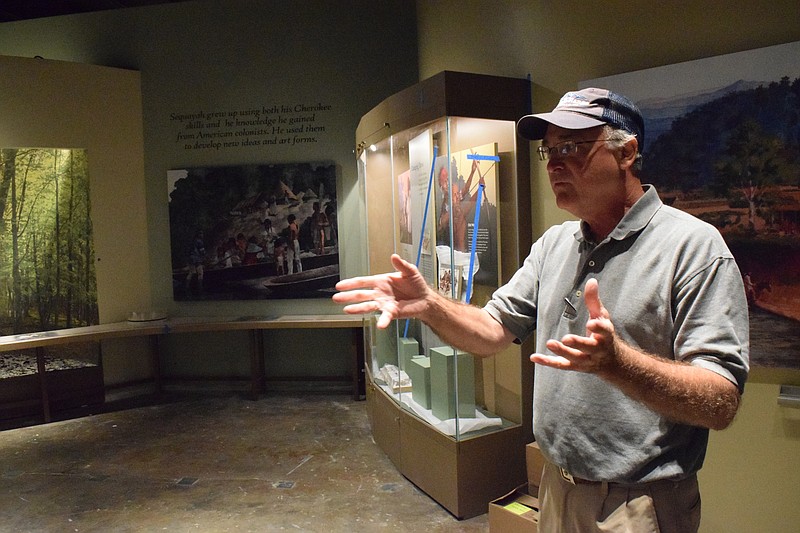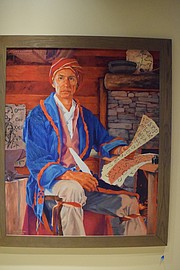VONORE, Tenn. - For the first time in more than three decades, the Sequoyah Birthplace Museum is getting a major makeover in the form of a new exhibit amid long-awaited renovations that began last summer.
The museum opened in 1986 presents the life story of the Cherokee Sequoyah, the inventor of the Cherokee syllabary alphabet, and stands on land where he was born and raised.
Museum board members Max Ramsey and Gene Branson, exhibit designer Lyn Henley and museum manager and director Charlie Rhodarmer said returning visitors will find a completely new exhibit that uses high-tech audio-visual programs and new artifacts to tell Sequoyah's story. The presentation of Sequoyah's story will be more kid-friendly and engaging, officials said.
"We're about halfway through installing the exhibit," Henley said Wednesday at the museum as a half-dozen or so contract workers were busily touching up paint and fine-tuning operating systems for the new audio-visual exhibits in the museum's two theaters and elsewhere.
"The exhibit casework and environment is in place and this week we're adding audio-visual programs," said Henley, whose Topanga, California-based business, Henley Co., is in charge of the design and work.
"We've got two main theaters - an orientation theater and a theater describing how Sequoyah invented the syllabary - and a few miscellaneous audio-visual programs along the way," Henley said.
This week, workers will install four life-cast figures created from living models to give them an authentic appearance, she said. The figures will present Sequoyah as he ages from around 10 years old to about 45.
A new collection of artifacts also will be installed this week, Henley said.
"Almost all of the artifacts have come from the McClung Museum [of Natural History and Culture] at the University of Tennessee, Knoxville," she said. "We've got artifacts from the time of Sequoyah's life, but we also have a few really primo artifacts that go back into prehistory, sort of setting the stage for what Sequoyah was born into."
Sequoyah, born at the Cherokee village of Tuskeegee around 1776 the son of Virginia fur trader Nathaniel Gist and Wut-teh, the daughter of a Cherokee chief, was exposed early in his life to the concept of writing though he never learned the English alphabet. He'd first seen how written language was used at the Tellico Blockhouse while learning to be a blacksmith. Later, he became a silversmith by trade and was among Cherokees who enlisted under Gen. Andrew Jackson to fight the British and Creek Indians in the War of 1812, according to biographical information at the museum and on its website.
Under Jackson, Sequoyah witnessed first hand how written language was used to communicate orders, record events and even write letters home.
After the war, Sequoyah began creating a new writing system for the Cherokee, making symbols to represent sounds for making words.
The syllabary was introduced to the Cherokee people in 1821 and within a few months thousands of Cherokee became literate, according to his biographical information. By 1825, much of the Bible and numerous hymns were translated into Cherokee, and by 1828, Sequoyah was publishing the "Cherokee Phoenix," the first bilingual national newspaper.
A towering representation of the newspaper can be seen in the new exhibit where a front page occupies an entire wall floor to ceiling and about 10 feet wide.
Rhodarmer, who interacts with visitors at the museum on a daily basis as its manager and director, likes the new design and the way new artifacts and artwork illustrate different periods of Cherokee history as the story of Sequoyah's life and his accomplishments unfold.
There is one low-tech piece he likes, too. It will be situated in the newspaper display.
"We'll have a 1833 Otis Tufts printing press. It's the closest thing that we could get to the printing press that was bought by the Cherokee Elias Boudinot who was the editor of the Cherokee Phoenix," Rhodarmer said. "We plan to do programs and use the press to print things."
Ramsey, the museum's first board chairman, a founder of the Trail of Tears Association and an honorary member of the Eastern Band of Cherokee Indians, said the new approach to telling Sequoyah's story should impress visitors with just how intelligent and far-seeing the man was.
The idea is "telling that story in a way it can be felt" while giving visitors an enjoyable experience, Ramsey said. He hopes visitors leave having learned something of Sequoyah's hunger to learn, share culture and to communicate ideas.
Fellow museum board member Branson agreed.
"This place is going to be beautiful. It's a great tribute to a great man," said Branson, who will become the museum's board chairman this fall and is an enrolled member of the tribe. "Who has accomplished what Sequoyah has accomplished? A written and spoken syllabary."
Branson also remarked that the actor who plays "Sequoyah" in the audio-visual portions of the exhibit, Wes Studi, brought an acting pedigree and Cherokee language expertise to the role to make it more authentic. Studi played in the character "Magua" in 1992 film "The Last of the Mohicans," among other Native American roles in film and television. One of Studi's nieces played the part of Sequoyah's mother in part of the museum presentation.
For visitors who have been to the museum before, Henley said the new exhibit "tells the story better. "I think we do a better job of walking people through his lifetime, taking you back to that time period and walking you through key events in Sequoyah's life.
Ramsey said the museum should reopen sometime in late summer or early fall.
Contact staff writer Ben Benton at bbenton@timesfreepress.com or 423-757-6569. Follow him on Twitter @BenBenton or at www.facebook.com/benbenton1.

